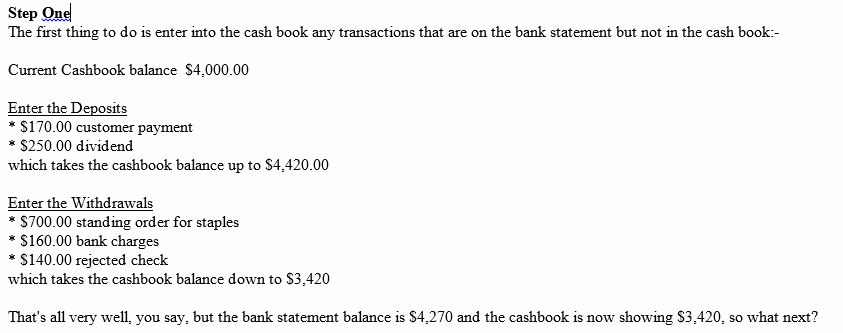Bank Reconciliation Statement
Meaning of Bank Reconciliation Statement
Define Bank reconciliation Statement
Bank reconciliation is the process of matching the balances in an entity’s accounting records for a cash account to the corresponding information on a bank statement. The goal of this process is to ascertain the differences between the two, and to book changes to the accounting records as appropriate. The information on the bank statement is the bank’s record of all transactions impacting the entity’s bank account during the past month.
A bank reconciliation should be completed at regular intervals for all bank accounts, to ensure that a company’s cash records are correct. Otherwise, it may find that cash balances are much lower than expected, resulting in bounced checks or overdraft fees. A bank reconciliation will also detect some types of fraud after the fact; this information can be used to design better controls over the receipt and payment of cash.
If there is so little activity in a bank account that there really is no need for a periodic bank reconciliation, you should question why the account even exists. It may be better to terminate the account and roll any residual funds into a more active account. By doing so, it may be easier to invest the residual funds, as well as to monitor the status of the investment.
At a minimum, conduct a bank reconciliation shortly after the end of each month, when the bank sends the company a bank statement containing the bank’s beginning cash balance, transactions during the month, and ending cash balance. It is even better to conduct a bank reconciliation every day, based on the bank’s month-to-date information, which should be accessible on the bank’s web site.
By completing a bank reconciliation every day, you can spot and correct problems immediately. In particular, a daily reconciliation will highlight any ACH debits from the account that you did not authorize; you can then install a debit block on the account to prevent these ACH debits from being used to withdraw funds from the account without your permission.
It is extremely unlikely that a company’s ending cash balance and the bank’s ending cash balance will be identical, since there are probably multiple payments and deposits in transit at all times, as well as bank service fees (for accepting checks, recording deposits, and so forth), penalties (usually for overdrafts), and not sufficient funds deposits that the company has not yet recorded.
The essential process flow for a bank reconciliation is to start with the bank’s ending cash balance, add to it any deposits in transit from the company to the bank, subtract any checks that have not yet cleared the bank, and either add or deduct any other items.
Then, go to the company’s ending cash balance and deduct from it any bank service fees, NSF checks and penalties, and add to it any interest earned. At the end of this process, the adjusted bank balance should equal the company’s ending adjusted cash balance.
Importance of Preparing a Bank Reconciliation Statement
Explain the importance of preparing a bank Reconciliation statement
Importance of Bank Reconciliation























Leave a Reply